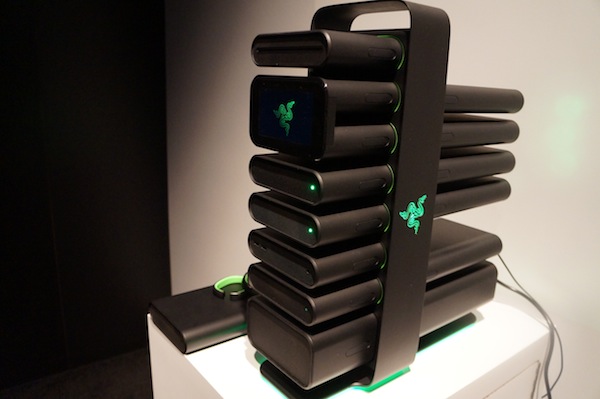Razer on Project Christine: "Not Entirely Promising"
Razer CEO Min-Liang Tan recently provided an update on Project Christine, and it doesn't sound like good news for those hoping this modular PC would hit the market anytime soon. In fact, it could be a long while before we see Razer's project take flight.
"The challenge is that it's not something we'd like to undertake alone," Tan said in a short interview. "We've had conversations with OEMs. It's not entirely promising right now because OEMs are excited about pushing products and not really innovating on that front."
Despite that, he claims that there have been "good conversations" with OEMs, and that there will be more to talk about as we get closer to the end of 2014. Tan says that Razer is looking to get two or three OEMs to sign up with the project.
Tan said back in March in another interview that the problem with getting Christine off the ground is the PC market, that it doesn't reward innovation, but rather commoditization and mediocre projects.
"It's become this vicious cycle of sorts," he told Polygon. "Anyone who tries to innovate, like for Christine, everybody wants it, but they all want it to be immediately at commodity pricing. And that's the thing, we're trying to encourage the rest of the OEMs, and we're literally telling them, 'Look, we're not going to make a cent out of this. We just want to be part of an ecosystem; we're happy to open this up to everyone to do that.'"
In the interview, he said that at least three or five OEMs together could make a huge difference to the entire PC landscape. The idea behind Christine is incredible: create a completely modular desktop that anyone can modify. Is the CPU feeling a bit slow? Unplug it and insert a newer CPU module. Need more space? Do the same with the storage module. Even more, send the unwanted modules back so that someone else can use them on a lower end setup.
"Obsolescence, wastage would go down dramatically at the same time, and when you think of costs, I mean a GTX card, 780 card, could last gamers three to four years if it's passed along and the guy who wants a top-of-the-line stuff would just have the top-of-the-line stuff," he said. "So, I think the biggest problem with Christine is really getting the people out there to use it."
Get Tom's Hardware's best news and in-depth reviews, straight to your inbox.
To see our CES coverage on Project Christine, head here.
Follow Kevin Parrish @exfileme. Follow us @tomshardware, on Facebook and on Google+.

Kevin Parrish has over a decade of experience as a writer, editor, and product tester. His work focused on computer hardware, networking equipment, smartphones, tablets, gaming consoles, and other internet-connected devices. His work has appeared in Tom's Hardware, Tom's Guide, Maximum PC, Digital Trends, Android Authority, How-To Geek, Lifewire, and others.
-
dovah-chan The big problem with this idea is that the only people who will be able to initially afford this are enthusiasts with a lot of money to spend (who probably already have fine desktop themselves) and will be a turn off to all other consumers. Most people that are in the PC gaming market anyway are quite knowledgeable on how to switch out their parts and what their system is comprised of. I think this is a good idea for easy maintenance but I prefer my own wonderful tower rather than a device that looks like a server rack. Maybe make it into a tower but all the parts be easily interchangeable or have some sort of casing for it?Reply
Also for people that have high end graphics cards or other parts that they don't use anymore they usually tend to sell them or give them to their friends. -
burkhartmj The reason OEM's aren't interested in this is because it's trying to solve a problem that doesn't exist, as such, it has no market. Those who spend serious money on their computer 9 times out of 10 build it themselves and are more concerned with performance/dollar rather than 'innovation' they don't really need. Those who don't want to deal with the complexity of building their own system 9 times out of 10 buy a cheap computer from the likes of Dell and HP. This device would only appeal to the types of people who buy falcon northwest or other boutique PC makers, which is an incredibly small market. It's an really cool idea, but without a viable market it's always going to be a hard sell to OEM's.Reply -
qlum Sure swapping them out at ease is a nice philosophy but even when you do compatibility may still get in the way of making it accessible. Think of psu capacity for example. You don' t want to overkill the psu on a light rig and a light psu may not even boot a stronger one.Reply
From a technical point of view the modularity also means that the individual components will be more expensive, where a cpu in a normal setup is just a chip in this modular setup it will be a chip, a cooler, part of a motherboard, a casing, the same will go for a lot of the other components. Now the cpu will be an expensive module in the first place but things like usb connectors and storage may really get in the way
Another thing is that if designs progress over time you will see a mix and match of different components with different looks which quite frankly looks a lot worse then a decent rig now.
And lastly and I think the biggest problem would be scale, for it to be feasible a lot of people would need to want it and I don't think there are enough that want it. I can tell you tech savvy people who love building and tweaking their rigs don't want them, people who don't know enough about this kind of thing would rather buy a new pc, hell they wouldn't even know if their gpu is the problem. they would run 20.000 programs on startup and screem that their pc is running slow. Sure they could trade stuff in but they probably won't. And lastly companies won't order them because they either have a good sys admin to build their rigs or if they are bigger do big bulk deals with oems, deals which sure could use incremental upgrades but knowing how long pc's keep getting used they won't be big on trading parts in to upgrade.
-
WithoutWeakness "The idea behind Christine is incredible: create a completely modular desktop that anyone can modify. Is the CPU feeling a bit slow? Unplug it and insert a newer CPU module. Need more space? Do the same with the storage module. Even more, send the unwanted modules back so that someone else can use them on a lower end setup."Reply
Sounds like exactly what PC users do already - swap out components that they wish to upgrade and sell the old parts on eBay or give them to a friend. Very, very few people scrap their whole machine and buy/build a new one and those who do have likely had their machine for 5+ years so it's reaching obsolescence anyway. OEM's don't want to touch this because it locks them into a contract selling small quantities of custom parts to Razer for thin margins when they can sell standardized components in bulk to resellers and system integrators. -
Bondfc11 I agree with all the comments above. It sounds to me that Razer is more in love with an idea they think is revolutionary, but really it isn't. We already do exactly what Razer is talking about - we swap parts all the time. As stated above to have this work on a truly large scale, and to get it to those that would need it (read: novice PC users), is nearly impossible. No one wants to pay top dollar for a product like this and have to update it - the standard user that is. The rest of us don't want to locked into a particular look or feature set. This is an idea that really never had a chance - and Razer was attempting to solve a problem that really never existed.Reply -
ferooxidan "Good advice..that you never take.But who would have thought it figures? isn't it Ironic? don't you think?" It sure took a long time from Razer to open their eyes.Reply -
voltagetoe It cannot be cooled properly, it cannot be silenced properly, plus it's ugly. these are ingredients of doom.Reply -
universal remonster "It cannot be cooled properly, it cannot be silenced properly, plus it's ugly. these are ingredients of doom"Reply
Actually, the cooling is the one and only aspect of this project that I found intriguing. And because of how it is cooled, I'm sure it would be relatively quite. You should read up on it. -
hoofhearted Sounds like history repeating itself. By the time you are ready to upgrade to the newer GPU module, you will have to upgrade to the newer Christine 2.0 compatible bus architecture or whatnot, which will require you to get new 2,.0 memory, cpu, storage and whatnot.Reply -
fuzzion I already have this system at home. Its called "Using your hands and a screwdriver". Patent pending.Reply
